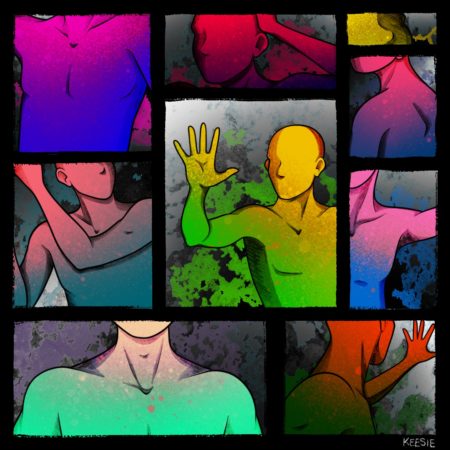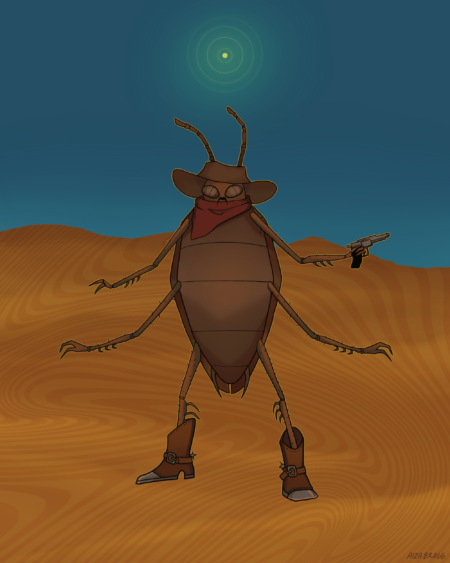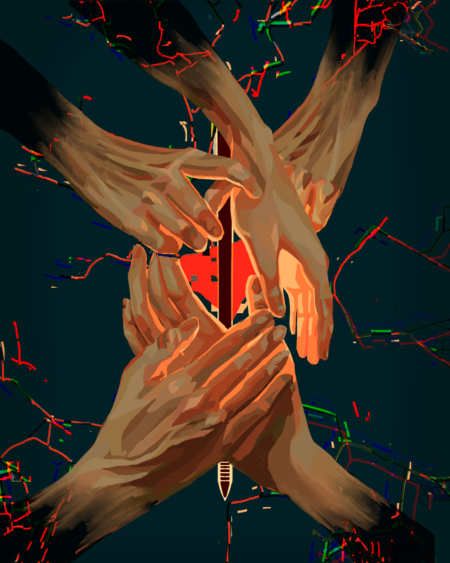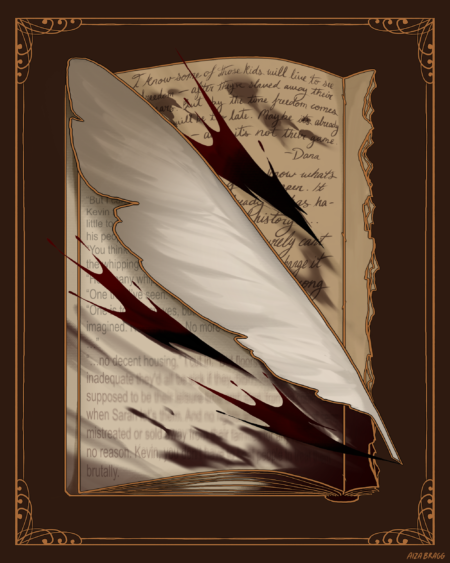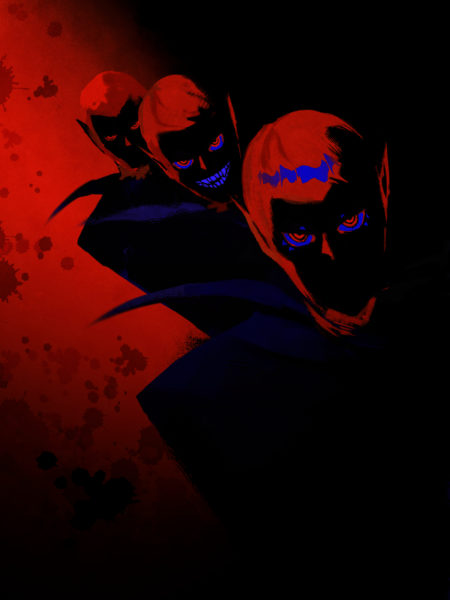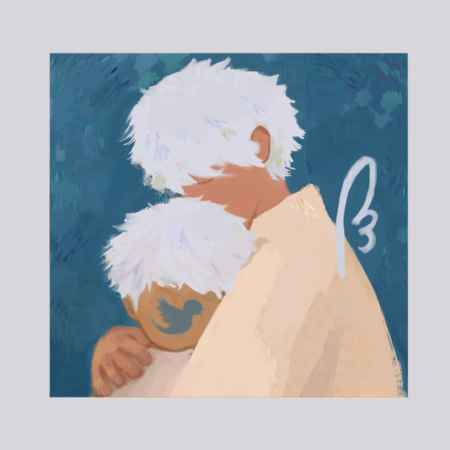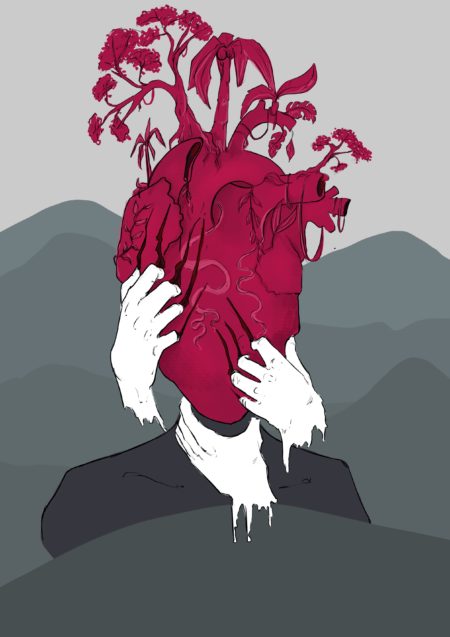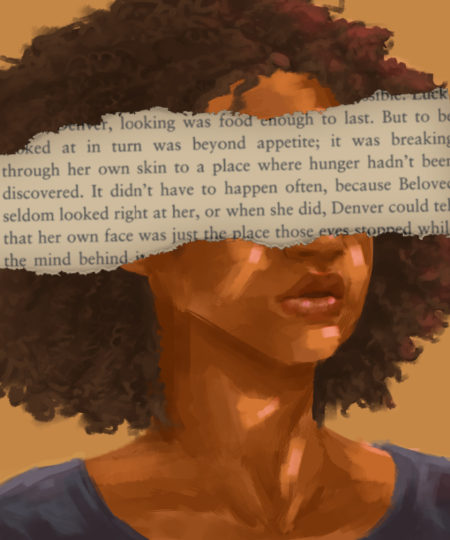Essay by Tova Gaster Art by Keeley Sieben In 1948, the Zionist military forces destroyed thousands of Palestinian villages, violently and irrevocably fracturing Palestinian society. The Nakba echoes through Palestinian collective memory and contemporary politics through the many displacements which have followed, most of which remain under-reported by Israeli-mediated historical recollection. One such suppressed massacre
TagAcademic Essay
Cowboys, Cockroaches, Capital: Reading Rawi Hage’s Cockroach as a Neo-Western
Essay by Tate Kaufman Art by Aiza Bragg The Cowboy exits through a door frame, the faint impression of his spurs imprinting on the desert floor, justice served. The Cockroach slinks through a kitchen drain, smudges of dirt left in place of his scuttling feet, justice wanted. Literature of the American West is armed with
“I wanted to write an endless book of time”: Metanarrative and Mortality in Rabih Alameddine’s Koolaids
Essay by Sally Elhennawy Art by Haley Cheng While considering the thematic elements that characterize the literary space occupied by HIV/AIDS writing, it is perhaps just as important to take note of the narrative forms utilized by writers in communicating these themes. The HIV/AIDS epidemic was characterized by a pervasive sense of impending mortality; consequently,
Co-constitutive Crises: Analyzing Rationality and Rhetorical Narratives of Agency in British Columbia’s COVID-19 Pandemic and Opioid Epidemic
Essay by Grace Payne Art by Karen Zhang According to data gathered by the Government of Canada, 3,002 deaths occurred in British Columbia from April 12, 2020 through April 4, 2022, as a result of the COVID-19 virus (bc.thrive.health stats). Meanwhile data released by the BC Coroners Service indicates that at least 2,224 individuals died
Futility and Frustration in Kindred
Essay by Colby Payne Art by Aiza Bragg In Octavia Butler’s 1979 novel Kindred, protagonist Dana is drawn suddenly into the past, where she must repeatedly save her slave-owning ancestor Rufus to ensure her future survival. In a 1997 interview, Butler stated that her inspiration for Kindred was an interaction with a member of the
What’s In A Name?: How Shakespeare Dramatizes the Mediatic Dynamic in Romeo and Juliet
Essay by Amelia Brooker Art by Haley Cheng European history is no stranger to periods of cultural shifts, but the Renaissance period brought on a shift of the mediatic kind, where tension between traditional orality and new-world literacy was strong and tangible enough to be dramatized on the stage. The stage play was a very
From the Land Beyond the Forest to the Shores of England: The Merging of Science and Superstition in Stoker’s Dracula
Essay by Corey Morell Art by Amy Ng In his quintessential Gothic novel, Bram Stoker takes the reader on a journey from the land beyond the forest to the land of hope and glory, from the unfamiliar to the known, from the old to the new. For the Victorians of the late 19th century, a
Biological-Soliloquies and Ascension to Canadian Canon
Essay by Kishoore Ramanathan Art by Karen Zhang In her contemporary novel Monkey Beach, Eden Robinson employs a unique technique throughout the text in which the narrative voice changes and digresses to discuss biological processes – which I will refer to as biological-soliloquies. Biological-soliloquies are dramatic deviations from the regular voice and narrative style that
Autonomy in John William Waterhouse’s Interpretation of “The Lady of Shalott”
Essay by Haylee Kopfensteiner Art by Aiza Bragg Alfred Lord Tennyson’s poem “The Lady of Shalott” has inspired countless artistic interpretations. One such interpretation is John William Waterhouse’s 1894 painting The Lady of Shalott Looking at Lancelot. While a popular way of reading Tennyson’s poem is to view the Lady of Shalott as a symbol
Cyborgs, Simulacra, and the Male Gaze: Deconstructing the Female Body in Yukito Kishiro’s Battle Angel Alita
Essay by Kaleena Ipema Art by Athena Li The cyberpunk comic series Battle Angel Alita introduces its female protagonist in the form of a detached cyborg head, fractured and abandoned in the dystopian landscape of the Scrapyard. Although bodiless, her chipped facial features and fragmented torso deliberately reveal enough femininity to identify not just a
The Consequences of Technologized Relationality in Klara and the Sun and “The Perfect Match”
Essay by Colby Ballingall Art by Amy Ng Human connection is defined as a “person’s subjective sense of having close and positively experienced relationships with others in the social world” (Seppala et al. 412). Psychologists argue that this connection is essential for health and survival (Seppala et al. 411), building on Maslow’s famous theories that
Conrad and Kincaid: Narratives of Dehumanization and Resistance
Essay by Carson Lamont Art by Luiza Ortiz This essay concerns the representation of the colonized in Joseph Conrad’s Heart of Darkness and the response of the colonized in Jamaica Kincaid’s A Small Place. To what extent does Kincaid in her contemporary vision repel the antiquated settler colonial gaze of Conrad? We are to believe
The Angel of Death: Analyzing Departures from the Chronic Mode of Suffering in David Wojnarowicz’s Close to the Knives
Essay by Audrey Castillo Art by Aiza Bragg Close to the Knives by David Wojnarowicz is an example of “AIDS literature” (Bradway 256) that traverses the queer consciousness during the American AIDS epidemic. It contains the disembodied voices of a population neglected by its government and murdered through the “internaliz[ation of] society’s hate” (Wojnarowicz 179).
When her “skin dissolved under that gaze”: Reclaiming a Remedial Look in Beloved
Essay by Cicely Williams Art by Miranda Yee As bell hooks notes in her scholarship on the Black gaze, “The politics of slavery, of racialized power relations, were such that the slaves were denied their right to gaze” (115). Quite literally, enslaved persons were often “punished … for looking,” and accordingly, she believes that this
“How vain, without the merit, is the name”: Proper Name Usage Invoking Asian Diaspora in Souvankham Thammavongsa’s How To Pronounce Knife
Essay by Aimee Koristka Art by Amy Ng Proper name usage—both in literature and in real life—creates a clear sense of identity for an individual, allowing for distinct separation from one person and another. They are the manner by which an individual is known. Hence, “[p]roper names can be considered as an interface between individuals
